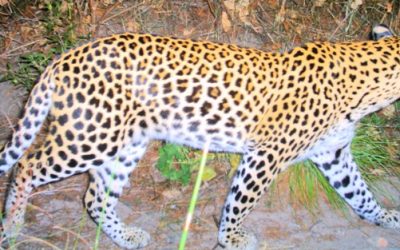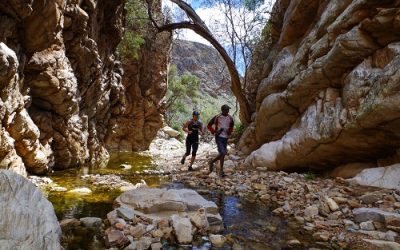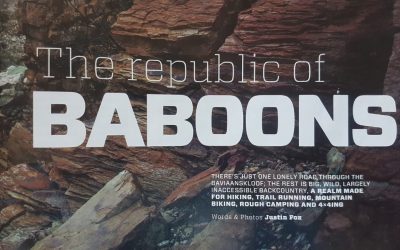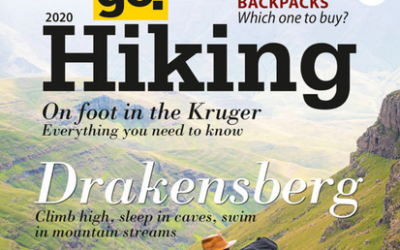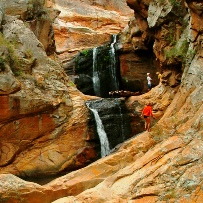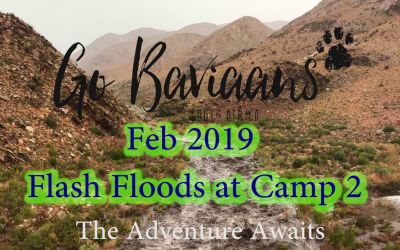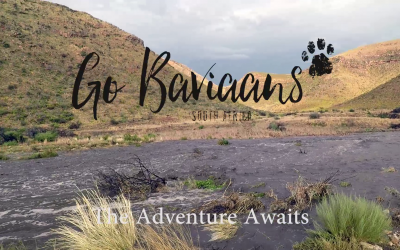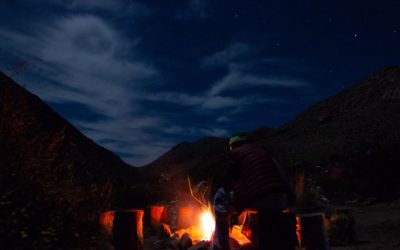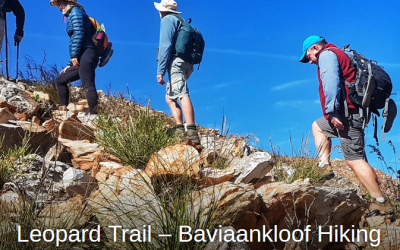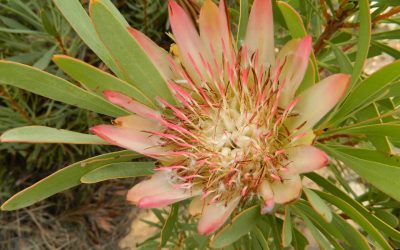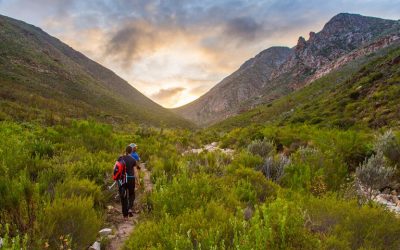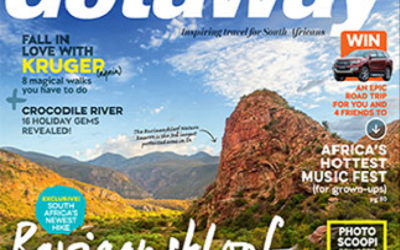Trail Mix
News from The Leopard Trail
Leopard Trail Booking Policy 2026
Bookings for the Leopard Trail for hikes in 2026 onward will be made per sleeping hut, not per person. Each sleeping hut sleeps 4 people, and there are 3 sleeping huts in total. To secure a start date, a minimum of 2 sleeping huts will need to be booked. If you only book 2 sleeping huts (instead of all 3), you’ll have a 2-month window to add the 3rd sleeping hut to your booking. After that, the unreserved hut will be made available to other hikers. The single communal cooking hut is for all 12 people, and is shared by people staying in the 3 sleeping huts.
(Bookings for January to March 2026 will open on the 3 February 9am)
WHY THIS CHANGE?
With the leopard trail fully booked out a year in advance, we aim to make sure we are giving as many people as possible a chance to hike the trail. In the past we kept each group exclusive – once you booked the minimum number of 8 hikers, we did not open that booking date up to other hikers. This meant we often had a hike starting with fewer than 12 hikers.
We value giving hikers the opportunity to have an exclusive group of friends and family. However, if the group cannot fill the 12 spots, we need to be able to open it up to other people. We have been talking to our hikers to get feedback and ideas on how to solve this problem. A key piece of feedback is that while hikers are happy to, and often enjoy, sharing the hike and communal hut with people not part of their own hiking group, they would strongly prefer to control who is sharing their sleeping hut of 4 people with them. In this scenario it makes more sense to treat each sleeping hut as the booking units, rather than per person.
BENEFITS AND CONSIDERATION
The upside of the new policy is that it allows a group to work towards an exclusive group of 12 people, sharing the 3 sleeping huts, while ensuring hiking spaces do not go to waste.
It keeps the minimum for the first group booking to 8, rather than increasing it higher. The potential challenge is that it requires hikers to book per hut in increments of 4 people – 4, 8 or 12 hikers.
Like every aspect of the Leopard Trail, we are very interested in, and receptive to, feedback. We’ll trial this system for bookings between January and March 2026 and welcome your feedback to ensure it’s clear, fair, and user-friendly.
PRACTICAL EXAMPLES
- A group wants to book a starting date for 12 people. In this scenario the group will book and pay for all 3 sleeping huts. No other hikers will be able to book for that date.
- A smaller group of people, less than 12 people, want to have complete exclusivity. In this scenario they will book all 3 huts. Even if there are not 12 people, they will still pay the full price for the 3 huts. To keep the per person cost to a minimum, they would strive to find additional people to meet the maximum of 12 hikers.
- A group wants to book a starting date. They have 8 people confirmed and keen. In this scenario the group will book and pay for 2 sleeping huts. If they do not increase the booking to include the 3rd hut after two months, the 3rd sleeping hut will be opened for an additional group of hikers to book.
- A group wants to book a starting date. They have 5 people confirmed and keen. In this scenario the group will need to book and pay for 2 sleeping huts. To keep the per person cost of the hike to a minimum, they will try and get to the 8 people that can sleep in those 2 huts. Even if there are only 5 people, they will still pay the full price for the two sleeping huts. If they do not take up the option of the 3rd sleeping hut after 2 months, the 3rd sleeping hut will be opened for an additional new group of up to four people to book.
- A group of four or less wants to book a single sleeping hut but do not want to book the minimum of 2 sleeping huts to secure their preferred starting dates when bookings open. In this scenario the group will not be able to book immediately when the booking dates open. They will need to wait for 2 months to pass from the date the bookings for that time period opens. After 2 months, those dates that have not had all three sleeping huts booked by a single group will be opened for a group of up to 4 people to book the remaining sleeping hut. They can choose from the dates that may be available.
- Two people want to book a hut just for themselves. In this scenario they can either be part of a larger group that books 2 or 3 sleeping huts and pay for a sleeping hut just for themselves. Alternatively, they can wait for extra huts to be released after the 2-month period. In either case they will pay the full price for the hut, even though there are just 2 people. The preference is that they opt to have a full hut of four people, as we are trying to create as many spaces for hikers to do the leopard trail as possible.
How to get the dates you want for the Leopard Trail
The Leopard Trail is often booked out within hours of us opening bookings, and so we thought we would share some notes on how to book in a way that increases your chances of getting the dates you want.
- Firstly, we do not give anyone early access or preferential bookings. When we open the bookings to the public, everyone has the same chance to get a booking. The only dates that may not be available are for our own team’s inspection hikes (usually one booking every quarter).
- All bookings must be made through our website.
- We usually open up bookings for three months at a time. The date and time the bookings will open will be publicized on our social media pages.
- You will need to make a minimum booking for at least 6 people, up to a maximum of 12 people. You can add more people at a later stage if required if you do not take all 12 spots immediately.
- When making a booking, select only the starting date of your hike.
- We use a third-party booking system that follows the same principles as most booking and ticketing services. There are a few things worth noting:
- The booking system only blocks out a booking as being not available when someone making that booking has completed the booking process.
- Therefore if you and another person both start booking a specific date at the same time, the first person to complete the booking will receive the date, while the second person will be told the date is no longer available even if they are in the process of finalising the booking.
- Given the above, your goal should be to complete your booking as quickly as possible. The main option to speed up this process is to select paying by EFT, rather than credit card, at the time you are making your booking, as taking time to enter credit card details and complete the payment will take longer to finalise the booking
Leopard Camera Project
We are getting trail camera’s back on the Leopard Trail – and YOU can be a part of the volunteer team.
At various times in the history of the Leopard Trail we have had game cameras in the mountains, and it is time to get camera’s back on the trail. Game camera’s help us to have a clear understanding of the wild animals walking the Leopard Trail, and let us share that information with hikers on the trail. The information is also very valuable for our partners the Eastern Cape Parks and Tourism Agency.
Project Outline
This project is driven by volunteers who share our passion for the area. We will be placing between 6-8 trail camera’s on the Leopard Trail at various points, with the aim to keep the camera’s operation for a full calendar year. These camera’s need to be visited every 2 months to replace batteries and download images.
Project Phases
First Phase: Technical planning.
This first phase involves the necessary research into trail cameras, identifying the best camera’s for our purpose and researching the best practice for setting the cameras. Our experience over the years has given us a lot of knowledge, and we update this by exploring new developments in camera technology as well as talking to other organisations that have current experience in using trail cameras.
Second Phase: Camera Installation
Over a few days, the camera’s will be installed on site and tested. The placement of the camera’s will focus on key points on the trail with natural funnels that channel animals onto the path.
Third Phase: Camera Monitoring
Every 2 months the cameras will need to be visited to change the batteries and upload the images. This will likely require 2 -4 days of walking to the various camera sites. The volunteer team will be based at Cedar Falls base camp, and visit the camera sites with 4×4 vehicles as far as possible and then walking in to the sites. The images downloaded will then be uploaded to a central data point for distribution to the Leopard Trail team and any of our conservation partners.
Project Operations
The project is run through a team of non-paid volunteers from the Leopard Trail hiking community. The purpose of using volunteers is to broaden the exposure our hiking community has to being a part of the Leopard Trail, and create opportunities for people with an interest and passion in the Leopard Trail environment to be part of our broader Leopard Trail team.
Volunteers will not be required to do all the trips and may only be involved in one or two of the trips based on how many volunteers are involved in the project.
The Leopard Trail will cover all the costs of the camera’s and equipmen. Accommodation will be provided to volunteers by Cedar Falls for the time that volunteers are on site working on the project.
Time Line
June – July Technical Phase
September – Camera Installations
November – First Camera Monitoring
January – Second Camera Monitoring
March – Third Camera Monitoring
May – Fourth Camera Monitoring
July – Fifth Camera Monitoring
September – Sixth Camera Monitoring
Want to be a part of the project?
If you would like to be a on the volunteer team for the project, sign up here. If you have any questions, please go to our Leopard Trail Hikers Community Page and drop us a question in the post talking about this project.
A shout out to our partners at the ECPTA
10 years ago the idea of the Leopard Trail was born around a camp fire by the team at Cedar Falls. Those sitting there were dwarfed by the night sky and the silhouette of the magnificent mountains of the Baviaans World Heritage Site Reserve – a call to create something special. The next day we worked through the plan of how it could work, what would be required and how to set it up as a community project. We had one problem though – we needed some mountains to walk through.
The best routes would take us into the reserve, and for that we would need the Eastern Cape Parks and Tourism Agency (ECPTA) to agree to the project and give us permission to send hikers into the great Baviaans mountains. We were confident that given the incredible potential of the project to combine community development, conservation and the promotion of a green economy, we could get the ECPTA onboard.
And indeed, over the next few months the ECPTA became an enthusiastic partner, supporting the idea wholeheartedly. While they did not have resources to help get the project started, the ECPTA team created the enabling environment and permissions for the project to keep moving, while also committing to see if they could help in the raising of funds for the eventual building of huts that would open the project to a wider audience of hikers.
It took us a good few years to get the hike to a point where we could get the first feet on the trail. Our community project finally received the Environmental Impact Approval we needed, and was able to borrow money to get a team of locals into the mountains for 8 months to create the trail and buy a 19 year old Land Cruiser to transfer hikers bags from night to night. During this time we were always hopeful that somehow we would find funds to eventually build huts for hikers, though for the time being the trail started with a tented camp option.
Five or six years into the project we received an unexpected and surprising call from the ECPTA. Through a partnership with the National Department of Tourism they had been able to secure funds for the building of huts on the trail! The actual construction of huts would not start for another two years, but for all of us involved we felt massive relief and excitement that huts would be coming.
The huts are now complete and are superb! The Leopard Trail is consistently included in most bucket lists of must do hikes in SA, and with the addition of the huts it is becoming vital for hikers to book way in advance to secure a spot. Through the partnership between the Leopard Trail and the ECPTA, the idea that was born 10 years ago has grown into a project that is far more than just a hike. It is a stunning example of how great partnerships can change lives.
So from the team that sat around that camp fire 10 years ago and all the people on the ground who are involved in the bigger project, we would like to say a heart felt thank you to all of our partners at the ECPTA. Here’s to a long future of creating a legacy for hikers and locals alike.
New video of trail running on the Leopard Trail
Getaway Magazine visits the Leopard Trail
It is always great when the the top magazines call and ask to pay us a visit. Not only is it good exposure for our project, but most of the time it is good solid outdoorsy type people. Justin was a good example, willing to traipse along as we checked cameras and hiked to the Cedar Falls. What we appreciate most about this write up is that he gets our mission – to provide the base camp from which people can explore the true magnificence of the Baviaanskloof from OUTSIDE of their vehicle. Most people visiting the area stay firmly inside their 4×4’s. The true magic however is what you find when you go for a hike, jump on your MTB or get your trail running shoes on.
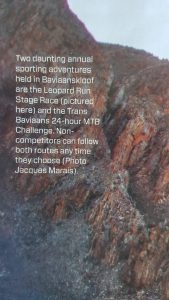
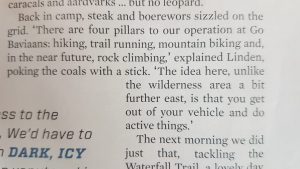

Go! / Weg! Hiking Guide 2020 features the Leopard Trail
As this hiking guide is still on sale, we can’t give away too much. You can buy it here: https://winkel.weg.co.za/produk/go-hiking-guide-2020/
In the article author Leentjie Du Preez gives a personal account and guide to hiking the Leopard Trail.
Jan – February 2020
We had an awesome stay and will be back. What an experience, we took photos but will never capture the mountains and the experience we had. We enjoyed our stay and Willem went out of his way to assist.
Don’s hike in April 2019
We really enjoyed our 4 day hike along the Leopard Trail, though I must confess it was tougher than I had expected. Possibly due to the recent heavy floods that clearly eroded many parts of the trail, however, this also lent an adventurous aspect – as though we were the first to explore the riverine areas and deep canyons. The latter were the highlight – beautiful, awe inspiring. And of course starry, starry nights …
The mess tents were comfortable and functional, though very sparsely equipped in terms of utensils, pots and pans. Showers and toilets were very good. Will be a great step forward when basic bungalows are available!!
Click on the link to see photo’s from our hike
https://drive.google.com/drive/folders/136paTGN92urbnKV74XISJ7nrNepXoenM?usp=sharing
We are most grateful for your support and patience in planning our adventure in Baviaanskloof,
Kind regards
Liesl, Tania and Don
SA’s Best Day Hike
A group of hikers last year commented that some places you just can’t capture with photos and videos. So for the next few weeks we challenged hikers to try their best to capture SA’s best day hike and share their footage. Here is a mix of the results. You decide.
Dramatic footage from hikers of the floods at camp 2
Great footage of the Flash Floods
Another 5 Star review from one of SA’s top hiking websites
Along with some really great photo’s, Hiking South Africa had some very cool things to say about the Leopard Trail. We are committed to making this one of the top multi day slack packing hikes in SA, and it feels great when others are say we are getting it right.
Here is some of the things they said, or you can read the full article here.
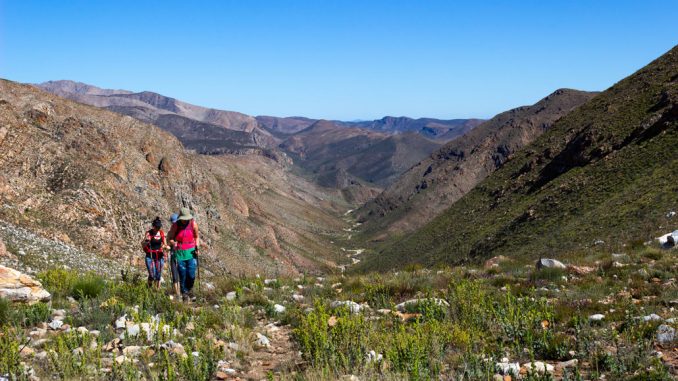
“The pristine nature and diversity of this landscape and its flora, especially during springtime, is an absolute treat. The Leopard Trail should by high on every fit hiker’s bucket list.”

“We had the privilege of hiking the trail a few weeks into spring and the combination of mild weather and flowering fynbos made for a wonderful experience.”

“All the campsites are beautifully laid out, with stones lining the paths and designated tent sites. The convenience of a communal “kitchen tent” and an outhouse with a flush-toilet is a real treat in such an otherwise pristine and wild setting.”
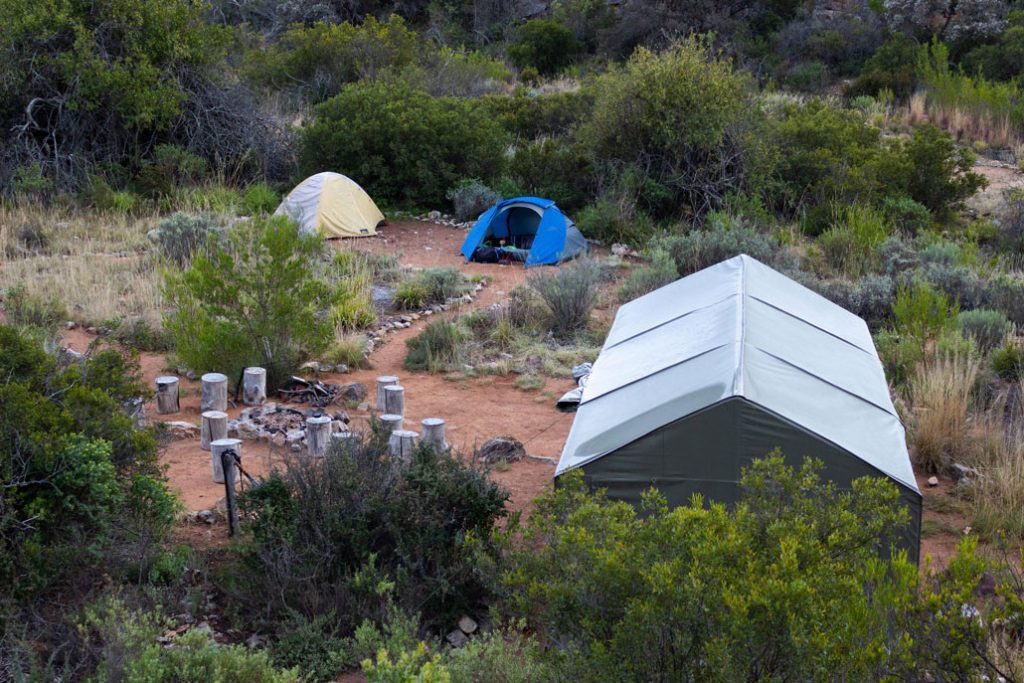
“A beautifully diverse and well laid out trail that winds its way through a unique and ancient landscape. The Baviaanskloof is a special place and the Leopard Trail takes one through some of its gems. This trail is a must-do for any fit hiker and I will certainly be doing it again.”
Thanks to and the team at Hiking South Africa for the great review and photos.
The complete guide to the Leopard Trail by No Speed Limit
Well known hiking blog site No Speed Limit describe themselves as “a couple on foot… and their dog.”
Leaving their dog behind on this occasion, they brought a group to try out the Leopard trail. Their review provides a VERY comprehensive guide to the leopard trail. This is from their introduction:
“It is difficult to rate all the hikes we have been done because some of them of very different and each has its own unique memories and experiences. That being said, you are going to find it difficult to top this hike. It has everything you could possibly want in a hike and more. It’s a perfect starting hike for those wanting to ease from slackpacking into full-blown multi-day hiking. The rugged beauty of this part of the country is unsurpassed, and it certainly is both a challenge and an adventure.
This is a great trail to ease you into multi-day hiking, because it has the element of slack-packing combined with the ‘roughing it’ style of sleeping in tents, outdoor (cold!) showers and navigating by head-lamp when the sun goes down. Each day of the trail has its own unique terrain, views and challenges. Depending on the time of year you visit this trail, you may need to contend with high temperatures, so you will need to plan your starting times accordingly each day. Don’t rush this trail. There is SO much to see along the way. You will need time for resting on the uphills (they are long and tough in the heat), taking in the views of the huge expanse of mountains, the beautiful flowers and enjoying the river along much of the route.
This trail is a great training hike if you are planning on doing the Fish River Canyon. Although much more green, the Leopard Trail boasts a very similar terrain to the Fish, and the long, hot days will be excellent preparation. You will also (quickly) learn the art of picking the perfect camping spot, setting up a tent on uneven ground in the fading light, and facing the dilemma of smelling clean and fresh vs putting your tired body into icy cold water just to get clean.
The trail itself is well marked, and the facilities at each campsite are more than adequate. Although initially a little skeptical, this method of slack-packing certainly has its perks. It was VERY nice having vegetables with dinner every night, instead of having to whip out the little gas stove and cook our dry, light-weight food that we usually pack for other multi-day hikes.
It is great to know that there is a local hike that includes so many varied aspects of multi-day hiking. It is definitely worth booking this route. We wouldn’t recommend it for children, but teenagers who are regular multi-day hikers would enjoy it. Whoever you are, you need to be fit and able to handle the heat. Don’t go if you can’t be without your cell phone or electricity to charge your devices. We recommend that you take all the available detours on this hike. They don’t add much in terms of distance, but a HUGE amount to the overall enjoyment factor.
Lastly – you ABSOLUTELY MUST do the day hike to Cedar Falls. We recommend doing it as a ‘Day 5’ of the Leopard Trail. Book the Hiker’s Hut for the night you return to base camp and then head off on this spectacular day hike adventure on your last day. It is phenomenal.”
Garden Route Trail provides a great guide to walking the Leopard Trail
A great local blog site, Garden Route Trails took a group on the Leopard Trail and produced a guide to walking the trail. This from their introduction:
” One of the last true wilderness areas in South Africa is undisputedly the Baviaanskloof, a series of folded mountains, canyons and valleys between Willomore and Patensie in the Eastern Cape. It is a botanical wonderland that transforms from Karoo through Fynbos and into pockets of Afro-Montane forest with hints of Spekboom along an east west axis.
The Baviaans is a landscape that begs to be hiked and thankfully the Leopard Trail provides a 4 day route to indulge avid hikers and explorers.
Based on the western side of the Baviaankloof, the Leopard Trail is a looped 62km slackpacking trail traversing folded mountains and following canyons. But don’t let the slackpacking aspect lure you into believing that this is an easy trail.”
Jacques Marais talks up the Leopard Trail in his latest book
*** A special thanks to Jacques Marais for including the Leopard Trail in your book “More things to do in Moer and Gone Places”. www.jacquesmarais.co.za
Here is a snippet from his book:
The destination
Province – Eastern Cape
Closest Town – Willowmore (84km)
Destination – Baviaanskloof
Baviaanskloof – the name is derived from the Dutch for “Valley of Baboons” – is a narrow valley blessed with pristine natural grandeur, and run with narrow gorges, streams, steep mountain passes and vast waving grassland plains.
The valley is just under 200 km in length, and encompassed by the Baviaanskloof Mountains to the north and the Kouga mountains to the south. The Valley itself lies at a lower altitude than the Karoo to the north. Intensified rainfall from the Karoo filters into the Baviaanskloof, making it a lush landscape supporting a wide variety of fauna and flora.
The Leopard Trail Hike is a moderately difficult four-day, three night slackpacking hike and is suitable for people with good hiking fitness. Along the way you will encounter a few steep and rocky ascents and descents, with intermediate daily distances for the duration of the hike.
The hike itself follows a circular route from the Cedar Falls Base Camp. The trail starts Day 1 (9.2 k, 3 – 5hours) with quite a stiff walk up Kick-Start Hill to the plateau. At the half-way mark, you can opt to take a detour to Gabriel’s Pools where you can have a swim in the small pools. This is the only place to get drinking water during the day. The detour is 570m each way, so think of adding an hour to the hike for the day.
Day 2 (18km, 5 – 8 hours) starts with an easy 5.5km walk along Rhebok Valley. At the end of the valley, there is another optional detour (314m each way) to the Cedars viewpoint. On the way, there is a stream with drinking water and a pool in which to cool down. From the detour point, the trail climbs up to the top of the saddle where you will have breathtaking views of the Kouga and Baviaans foothills before dropping down to the Reflection Pools where you can swim and top up your drinking water.
Day 3 (22km, 6-9 hours) is the longest day of the hike. The trail leads you through pristine wilderness deep in the heart of the Baviaans and Kouga mountain landscape towards three major climbs: Honeybush Hill, Inconvenient Truth and Ain’t So Bad. At the half-way point, Draaipunt, there is yet again a 224m detour for drinking water. The remainder of the day is spent walking down the incredibly beautiful Kosey Kloof for 9km to the third overnight spot.
Finally, on Day 4 (12km, 3-5 hours) you’ll set off through the beautiful Birdsong Valley, only to reach Fond Farewell, a steep climb to the plateau after 4km. Once on the plateau, the trail leads through the Cauldron, a series of two small valleys followed by a steep descent into the Cedar Falls alley, which brings you back to base camp.
The accommodation
This is a slackpacking hike, but you have to bring your own tent, mattresses and sleeping bags; these are then transported from campsite to campsite in time for your arrival, so all you have to carry is a daypack with food and drink.
Overnight sites have a catering tent that provides a communal space for protection from sun, wind and rain. Each tent has a table, some benches, a sink and a twin gas cooking plate. Camping sites have been cleared around the catering tents. Overnight camps are equipped with pots, pans, braai grids, crockery and cutlery. Water is piped from the mountain streams into water tanks.
Types of Accommodation: Self-Catering
Camping: Yes – maximum 12 tents
Caravanning: No
Alternative Accommodation
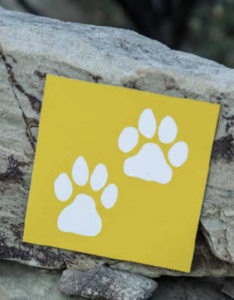
Red Cliffs Farmhouse is an ideal base for hikers. The farmhouse is built around a 150-year-old stone-wall room that has been added on to and expanded over the years and now provides a tranquil refuge in the kloof. The large open-plan lounge has a fireplace for the cold winter nights. Four bedrooms can sleep up to 12 people. Linen and towels are supplied by prior arrangement. Accommodation is in two rooms with a king-sized bed in each, one room with six single beds, and one room with two single beds. There are two bathrooms, one with a shower and one with a bath.
Cedar Farmhouse sleeps eight, with bedding and towels supplied. Sleeping options include one double room with a king-size bed and three twin rooms with two single beds in each. There are two bathrooms and a private outside shower, spacious lounge, well-equipped kitchen and an old-fashioned wraparound veranda. The indigenous garden has a braai area.
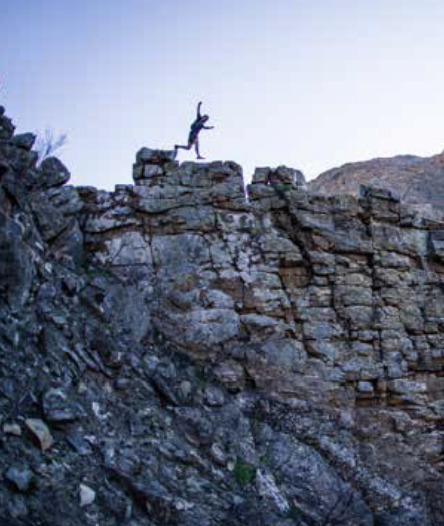
Reasons to visit
The Baviaanskloof Wilderness Area is one of the most rugged and beautiful places in the country, with pristine wilderness, spectacular mountain passes and abundant wildlife, including the inevitable troops of baboons after which the area was named.
Go hike
In addition to the Leopard Trail, The Cedar Falls Day hike should not be missed. The trail meanders alongside clear flowing streams inside beautiful kloofs. Starting and ending at Cedar Falls Base Camp, it will take 4- 6 hours (including lunch and swim stops). At two points along the trail, you will have to swim a few metres to get through a narrow gorge. If hiking in winter, be aware that the water will be very cold.
Go view San Paintings
The guided San Rock Art Walk is only available to guests staying overnight at the Cedar Falls Base Camp. The two-hour trip (45 minutes each way, with half an hour at the caves) takes you through the Leopard Kloof Valley to the San cave where the stunning Running Man painting is found. A 30cm image of a medicine man, wearing a mask and carrying hunting sticks, dominates the paintings.
Go run
The Leopard Trail Run is a circular two-day run, using the path of the four-day Leopard Trail Hike. Runners combine days 1 and 2 into a one day and days 3 and 4 into a second day. The trail is along a single track path and is 70% runnable, but care must be taken on the remainder due to steep ascents and descents where there is loose material on the path (more info at www.ecobound.co.za).
Go crank
The attraction of the Baviaanskloof is best experienced on a multiday cycle ride, with overnight stops at self- catering farm cottages or campsites along the way. Spending time at Geelhoutsbos, Rooihoek and other hideaway spots along the way is a must. You may, however, feel the need for company if you plan on tackling this monster, and the best way of doing this would be to enter the annual Trans-Baviaans 24-hour MTB marathon. This event finishes near Jeffreys Bay and totals 230km – more info on www.transbaviaans.co.za .
Important info
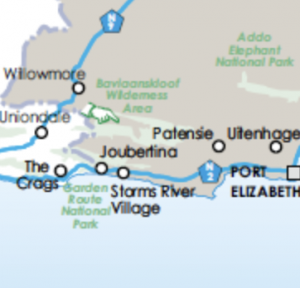
Find your way: From Willowmore, take the N9 towards Uniondale. After 3km out of Willowmore take the road on the left signposted “Baviaanskloof”. Keep going straight on this road for 31km, at which point you enter the Nuwe Kloof Pass. Drive a further 7.4 km to a road on the right marked “Cedar Falls”. Drive 7km to Cedar Falls Base Camp.
Access: Gravel Roads
Cell Reception: Intermittent
GPS Coordinates: S33°34’31.28” ; E23 42’57.33”
Website: www.gobaviaans.co.za
Tel: +27 (0)74 939 4395
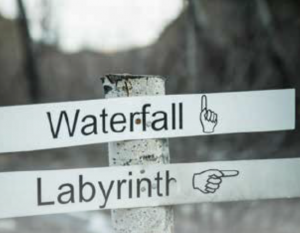
Recovery well on the way after the fires
As most of our friends know, a mountain fire swept through our section of the Baviaanskloof in December. As sad as it was to see the land burnt and as wonderful as it is to watch the veld recover, we must accept that fires here are a natural phenomenon, and an important ecological process in the fynbos ecosystem.
It is the magic and beauty of this ecosystem and landscape that makes the Leopard Trail such an iconic trail in South Africa, and we accept that fires of this nature are a part of our operating environment.
For some insight to the recovery of fynbos, here’s a timeline from the desk of the ecologist at The Eastern Cape Parks and Tourism Agency:
“Fire is normal in fynbos systems and many plant species require fire. It is the most important natural disturbance in fynbos biomes. Fire provides an opportunity for seedling establishment – most recruitment of seedlings in fynbos happens in response to a fire. As fynbos vegetation ages, there is a decline in diversity as the vegetation becomes tall and some species are shaded out. Fire is therefore required to maintain diversity.
“The response of fynbos vegetation to fire is complex. Plants have various fire survival strategies, principally divided into two groups: resprouting plants and reseeding plants. Resprouting plants often have insulating mechanisms to allow them to survive fire (for example, Protea nitida has thick bark on its stems that insulates buds from fire damage. Resprouters include plants that resprout from fire-resistant rootstocks, such as the grasses and species such from the Proteaceae (Leucadendron salignum, Protea cynaroides), Restionaceae (reeds) and Cyperaceae (sedge) families.
“After a fire, the vegetation will move through various stages until reaching its climax structure and composition – this is known as post-fire succession.
“Early stages are characterised by a high cover of grasses, the emergence of post-fire ephemerals and also flowering of geophytes. Resprouting of perennial shrubs occurs very quickly after the fire (within two weeks). With all the new growth, the veld looks very green. The rejuvenation of grasses after a fire is very important for the grazing mammals inhabiting mountain fynbos (such as Cape mountain zebra and red hartebeest).
“Fire stimulates flowering in certain species, especially in geophytes (plants with underground bulbs or tubers). This is largely due to the indirect effects of fire, such as changes in soil temperature and nutrient availability. In the Baviaanskloof, species that can be found flowering in response to a fire include Watsonia knysnana, W. schlecteri and W. wilmaniae, Boophane disticha, Brunsvigia josephinae, Cyrtanthus montanus, Haemanthus coccineus, Haemanthus sanguineus, Nerine humilis, Disa pillansii, D. porrecta and D. cornuta, Satyrium acuminatum and S. bicorne.
“Fire ephemerals are short-lived species that complete their life cycles in the period immediately after a fire. Germination is stimulated by fire. Species include Ursinia paleacea, Aspalathus spp., Thesium strictum and T. virgatum.
Some reseeding Erica species appear to have a delayed germination after fire and only appear after more than a year after a fire.
The reseeding Proteaceae are generally the slowest to mature and have long juvenile periods. For example, Protea neriifolia, P. mundii and P. repens take at least four years (often longer) to begin flowering in the Baviaanskloof.”
You can also an idea from this site: http://www.fynboshub.co.za/fynbos-diversity/when-the-smoke-settles-new-life-begins/
ABOVE: A little protea snapped on The Leopard Trail by Kobus Conradie in April 2017
Getaway Mag Does The Leopard Trail in Photos
Getaway magazine editor Sonya Schoeman & photographer Teagan Cunniffe walked our four-day hike last year.
See how Teagan captured their expedition in In Photos: Baviaanskloof’s Leopard Trail.
Trail Mag’s Leopard Trail Run Review
Last year passionate trail explorer Andy Wesson did our challenging two-day trail run in one day. Respect!
This year, he and his mates are doing it again, from the other direction. We’ll let you know how he finds it.
You can download and read his review in TRAIL mag here:
TRAIL Mag review of Leopard Trail Run 2016
Discover what’s in the latest issue of TRAIL mag, and keep up to speed by following them on Twitter and Facebook.
Getaway Magazine’s cover story on the Leopard Trail
This article is full of humour and grit as the Getaway team come to grips with the heat and beauty of the Leopard Trail. We love it when the writing matches the landscape – beautiful, truthful and crafted through years of hard work.
“And finally I’m standing on top of the world, incredulous at what I’ve achieved, and marvelling at the exquisite, untouched world around me, while a pair of eagles soars close by, judging life and death below. I think to myself, I’ve walked through a story about the land, the people, the creatures, the heartbreak they’ve all faced, the hope and philosophy and exquisite landscape. And then I turn and take one step, and then another step and then another…”
Here are the introductory paragraphs, and we suggest you read the rest yourself at the link below:
“The Baviaanskloof is known for its hoards of baboons. It is, in fact, what Baviaanskloof means: the valley of baboons. These four-legged rascals are splendidly adapted to this phalanx of bony orange rocks that jut out into the vivid blue sky. But in four days we see only one – even baboons have the sense to exert as little energy as possible here at midday in the height of summer. Not us, though. No. It’s day one, 2pm, and there we are, trudging up a deeply rutted stony former truck track, and with each crest another appears, higher, longer – endless. It doesn’t take long to sift the wheat from the chaff, and the chaff is me and an Irishman in his seventies who has walked the entire Camino de Santiago, but is now off to one side making an alarming wheezing sound. My own face is puce, my head throbs and I’m so overheated I want to throw up. Whose idea was this?
Linden Booth is strolling in front of me, chatting comfortably, cool as a Bishop’s old boy at a polo match. It was his idea to buy a farm in the furthest corner of the Baviaanskloof. His idea to create this murderous hike. His idea to leave at 2pm, when the sun is at its most vicious. His idea to tell us we would be just fine, I would be fine. But I’m so not fine. I’m doubled over, with barely the presence of mind to twist open my Stanley flask and pour out some iced mint water that I sip at like I’m on my deathbed – any kind of bed will do at this point. I’m an atheist, but this could be the turning point. I send up a prayer, then remember that I have blasphemed up every inch of this God-damned track; I’m going to hell! Except this already feels like Satan’s domain.”
Read about all the trail and Sonya’s experience in Why You Should Walk the Baviaanskloof’s Leopard Trail.

